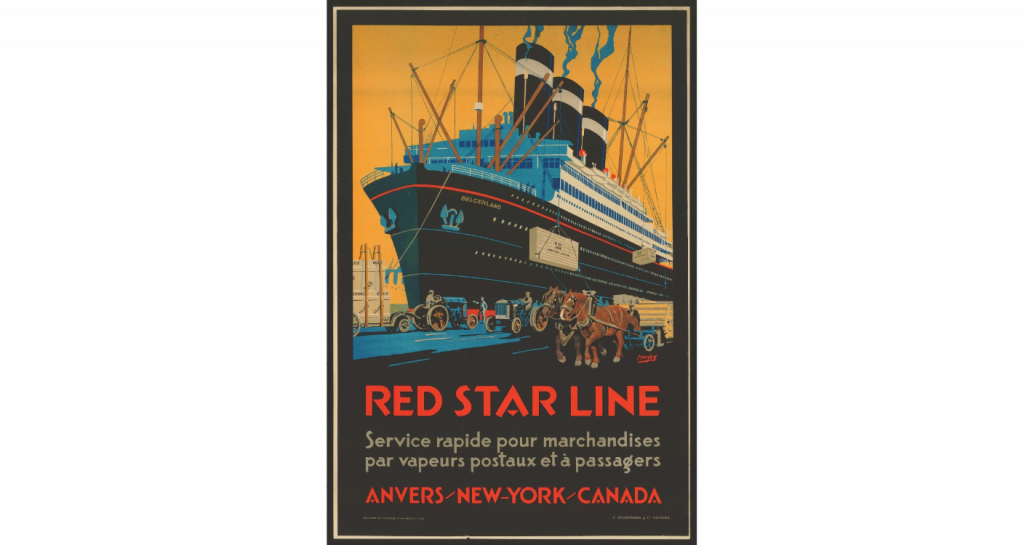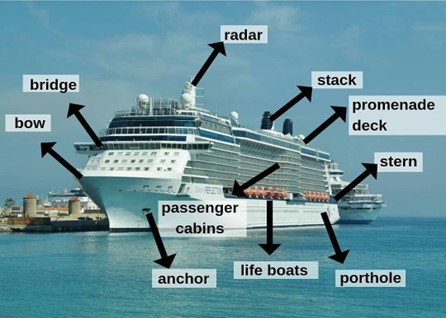Lesson Plans
Red Star Line Company
- Belgium
- Water
- B1
Warming Up
- What can you see in the picture?
- Which words come to your head when you look at it?
- Can you try to classify the words into positive or negative ideas?
- Would you like to be in such a ship?

Vocabulary


Do you know what a witch-hunt is?
Take a look at the picture and try to guess the meaning.
Cultural Heritage Background
Listening
-
-
- Ship Sheep
- Chip Cheap
- Fit Feet
- Rich Reach
-
Listening Comprehension
There were up to 2500 passengers per ship. Third-class passengers had to pass through administrative and medical examinations first. First-class and second-class passengers were allowed to board without an examination.
Reading the story
The Red Star Line was a Belgian shipping company with a regular service between Antwerp and New York or Philadelphia. It operated from 1872 to 1935 and fell victim to the stock market crash of 1929.
The Red Star Line was officially called Société Anonyme de Navigation Belge-Américaine or SANBA for short. Its main activity was transporting oil from the United States to Europe and passengers on the way back. Later, the American government banned the transport of oil on passenger ships, so the Red Star Line began to focus on passenger transport.
Passengers gathered to board one of the Red Star Line’s 23 ships (or one of the more than 150 ships chartered by the shipping company). The third-class passengers first had to have their luggage disinfected and then go to the doctor to be examined. At first, the examination was conducted outdoors; only after many complaints did the Red Star Line build an additional building. By 1913, the line had reached its peak: in that year alone, it carried 70,075 third-class passengers. In total, between 1873 and 1934, about two million emigrants travelled to America on the Red Star Line. Many of them came from Eastern Europe and about a quarter were Jews. One was Albert Einstein.
The physicist Albert Einstein, whom Time Magazine proclaimed “Man of the Century” in 2000, was a regular passenger on the Red Star Line. Einstein was Austrian by origin and lived in Berlin. But he had family in Antwerp and was a good friend of Queen Elizabeth of Belgium, the painter James Ensor and other Belgian personalities.
In the summer of 1932, the Reichstag elections made Hitler’s Nazi party the largest in Germany. This was followed by violent riots and Einstein, who had called for resistance to the Nazis, was advised to leave Berlin until calm was restored. Then he travelled to Belgium. While he was there, he decided to take up the offer of a part-time appointment at the Princeton Institute for Advanced Studies. His intention was to divide his time between Germany and America.
When Hitler came to power in Germany on March 23rd, 1933, Albert Einstein and his wife Elza Koch were on their way back from the United States to Berlin. While onboard the Red Star Line’s Belgenland he learnt that the Nazis had confiscated all his possessions and had started a proper witch-hunt against the Jews. They decided it was not possible for them to return to Germany. After the Belgenland arrived in Antwerp (March 28th, 1933), the couple travelled on to the Belgian coast. Queen Elizabeth was fearful for Einstein’s safety and ordered the gendarmerie to keep him under constant protection.
In Belgium Einstein gave several talks and received friends including James Ensor and the writer Aldous Huxley. It was probably the Nazis’ murder of Professor Theodore Lessing in Czechoslovakia on August 31st, 1933, that convinced Einstein of the danger he was in. Shortly afterwards he left for London. A few weeks later Elza also left Belgium, via Antwerp, on board the SS Westernland. Einstein himself boarded the ship in Southampton to accompany his wife to America. They sailed into New York on October 17th, 1933. Einstein settled in the United States and became an American citizen in 1940.
Reading Comprehension
Grammar
As the story takes place in the 19th and 20th centuries there are a lot of past tenses in the text.
Regular: base form + ed
Irregular: different forms
Additional activities
- If you want to learn more about the passengers of the Red Star Line, go to https://redstarline.be/en/redirect-verhalen
- Immigrants to the US arrived first at Ellis Island, where they were processed. You can learn more about their experiences here: https://www.statueoflibertytour.com/blog/what-life-was-like-for-an-ellis-island-immigrant/
- Can you think of a very famous ship that started the trip from Southampton to New York? Read more information here: https://en.wikipedia.org/wiki/Titanic
Extra resources for learners
- Links to 4 Elements in Arts Resource Library
- The Last Titanic Survivor Remembers Hitting the Iceberg https://www.youtube.com/watch?v=HRAGMW4n4mc
